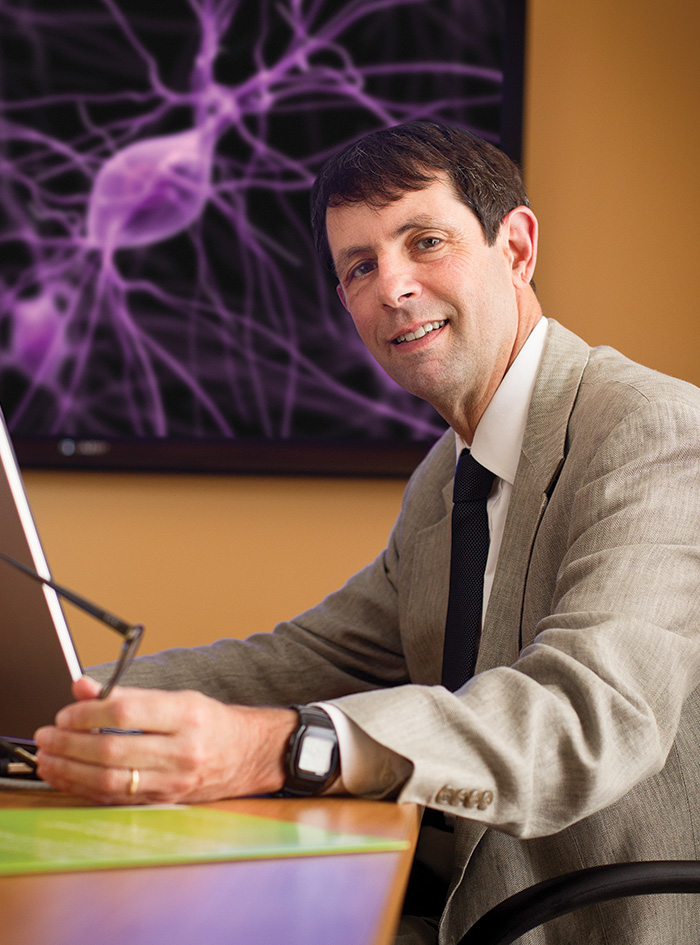Chief of the Division of Alcohol, Drugs, and Addiction, Roger D. Weiss, MD, has long been a leader in the field of substance addiction treatment, research, and education. It was no surprise when he was tapped by the National Institute of Drug Abuse (NIDA) to lead the first large-scale study to address treatment of prescription opioid addiction.
The results of the six-year study, announced in the December 2011 issue of the Archives of General Psychiatry, sparked nationwide interest among those who treat prescription opioid addiction and triggered McLean to change its services to more effectively treat patients.
“We learned that individuals addicted to prescription painkillers are more likely to succeed in treatment with the aid of the medication buprenorphine-naloxone (SuboxoneTM),” explained Weiss. “We also saw that the standard of tapering patients off of medication after three months was ineffective, creating a high incidence of relapse.”
Particularly notable is that the first study to point out the potential utility of buprenorphine for opioid dependence treatment was conducted at McLean and published by Nancy Mello, PhD, and Jack Mendelson, MD. The landmark study, appearing in the journal Science in 1980, laid the foundation for Weiss’s work decades later and exemplifies the best tradition of using translational neuroscience to produce effective treatments in psychiatry.
Part of the NIDA Clinical Trials Network, Weiss’s trial was the first randomized large-scale clinical trial for the treatment of prescription opioid misuse, involving 10 sites nationwide and more than 600 treatment-seeking outpatients dependent on prescription opioids who were either taking more than prescribed or using them illicitly. Each participant received Suboxone—a combination of buprenorphine, which alleviates opioid withdrawal and craving, and naloxone, which prevents misuse if the drug is not taken orally as prescribed. In conjunction with standard medical management, physicians evaluated treatment effectiveness and recommended abstinence and self-help participation. Fifty percent of study participants also received additional intensive addiction counseling.

According to Weiss, 49% of patients experienced substantial decline in their opioid use while taking a 12-week course of Suboxone. However, once the medication was discontinued, patients had an extremely high rate of relapse. Monitored in four-week increments, individuals showed an increasing rate of relapse the longer they remained off Suboxone.
Hilary Smith Connery, MD, PhD, clinical director of the Alcohol, Drug, and Addiction Treatment Program within McLean’s Division of Alcohol, Drugs, and Addiction and the principal investigator of the study on the McLean campus, noted that the study’s results were striking.
“These results were crystal clear—our patients were motivated, doing very well in treatment, and wanted to stay sober, but when their medication was tapered off after three months, the relapse rate skyrocketed to 90%,” she said. “Typically, it can take 10 years for research results like this to translate into clinical practice, but because this study was being conducted within our programs and we were so familiar with the work, we were able to use these findings to make changes to our treatment approach for patients almost immediately.”
With Weiss’s findings as a trigger, Connery and her team have developed a multipronged approach to make services more accessible and improve an individual’s likelihood of remaining off opioids. The actions they are taking include educational outreach to patients and families as well as clinicians, training psychiatrists to become licensed prescribers of Suboxone, and collaborating with other entities within Partners HealthCare to bring services to the community.
“Our commitment to providing the best possible clinical outcome extends beyond the McLean campus,” said Connery. “It really is a regional and national effort to train physicians so that they can develop treatment programs within their own communities, educate patients and families so they can advocate for themselves, and conduct national clinical research that results in ever-better care.”
Regaining a Life
At age 24, G.K. operates a successful business dedicated to helping clients realize their fashion potential, actively writes music, and has a growing circle of friends. With his exuberance for life and infectious upbeat attitude, it is hard to look at him and think “recovering drug addict.”
However, G.K. knows all too well the painful cycle of addiction. He began regularly smoking marijuana when he was 14. Over time, he began using cocaine, before developing a dependence on prescription opioids, such as OxyContin® and Vicodin®. In August 2011, after relapsing for a second time less than two weeks after leaving a rehabilitation program, G.K. was admitted to McLean’s Alcohol, Drug, amd Addiction Treatment Program, where he stayed in the six-bed residential program for three weeks.
“McLean in its entirety saved my life. Actually, McLean enabled me to save my life,” said G.K. “McLean looks at addiction in a slightly different way than do the other programs I have been to. It’s a more hands-on approach and the treatment teams showed me that I was in control of my addiction. I never felt in control before.”
While in the residential program, G.K. began intensive group therapy, along with Suboxone—a medication used to treat opioid addiction. He has continued to participate in groups and take medication. He also credits his treatment team with helping him change his thought process—something that has continued through a McLean-based dialectical behavior therapy (DBT) group that he recently joined.
“McLean staff were key in helping me change my way of thinking from an addict’s mindset to an ex-addict’s mindset,” said G.K. “I just don’t think like I used to and it’s a liberating feeling. The combination of the different groups—the Suboxone group and the DBT group—have helped me work through a lot of issues. Thanks to McLean, I feel like I have conquered drug addiction and I have my life back.”
Media Requests
Journalist or member of the media? We are available 24/7 for media requests.

